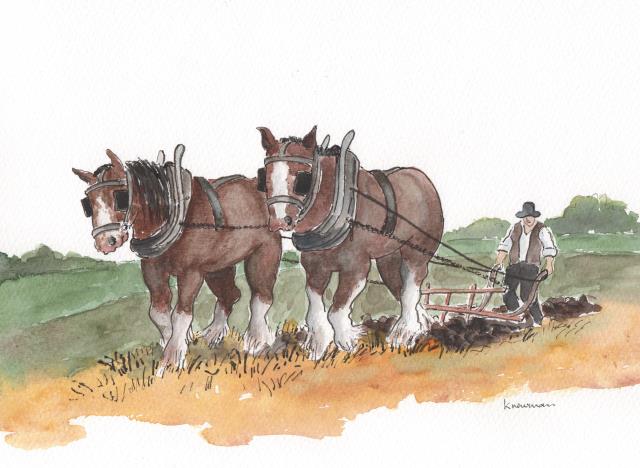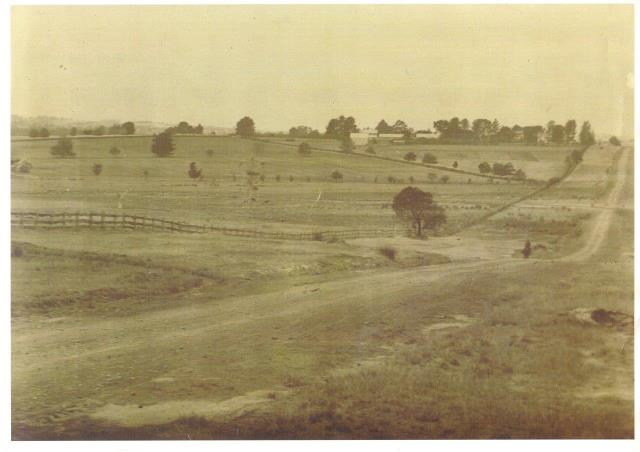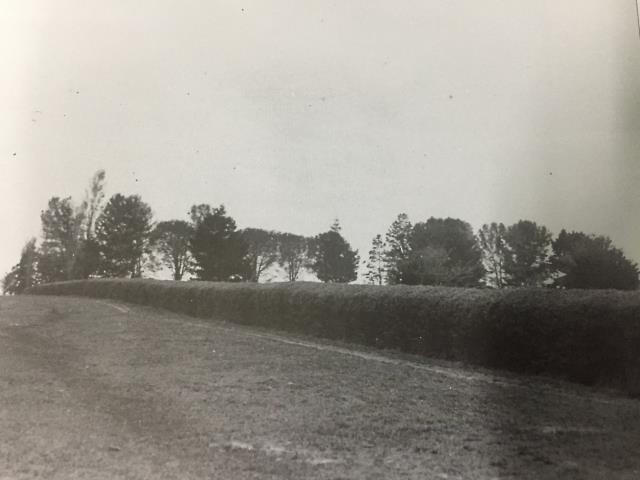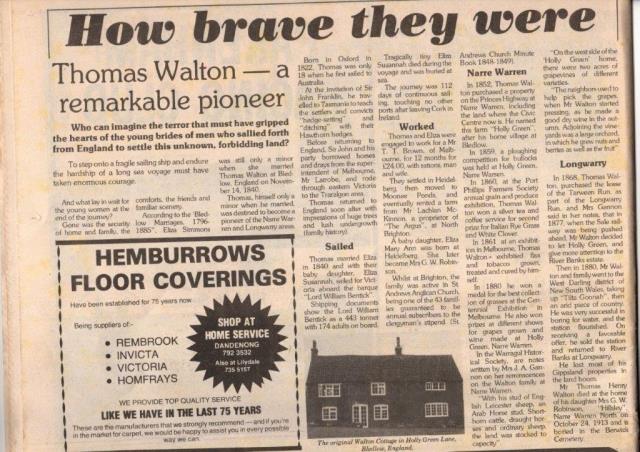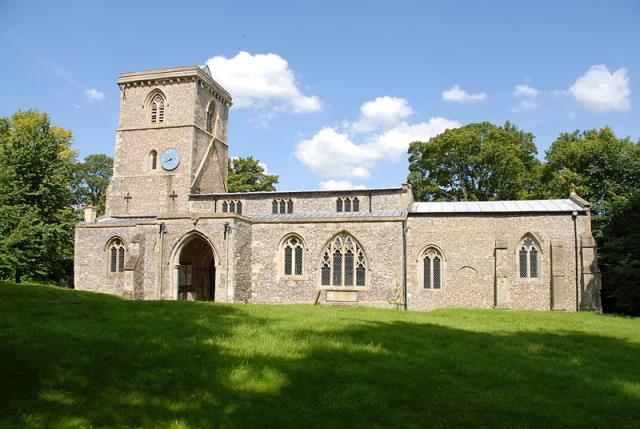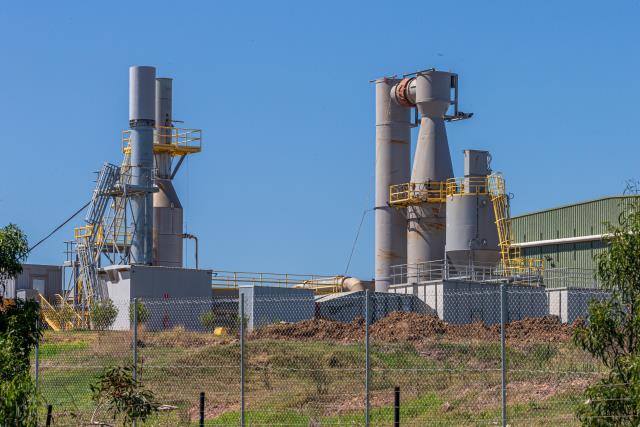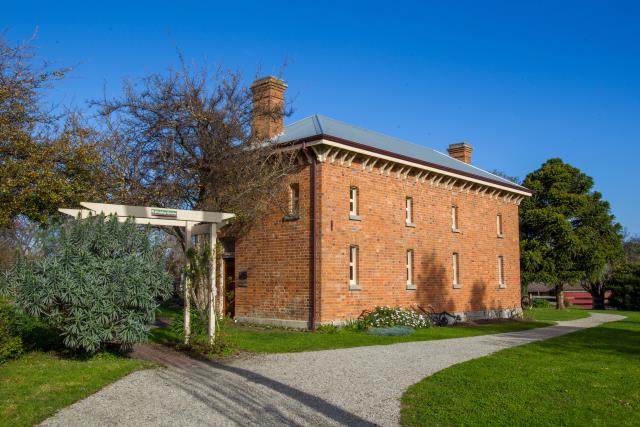Thomas Walton made a major contribution to agricultural endeavours in the Narre Warren area and was a prominent figure in the show scene, with a particular passion for Clydesdale horses and ploughing competitions, as NEIL LUCAS explains in his latest look at the significance of place and street names in the region.
Walton Court, Narre Warren
Thomas Walton was born in Oxford, England in 1822 and as a young man lived in a house in Holly Green Lane, Bledlow in Buckinghamshire. As an 18-year-old he married an even younger Eliza Simmons in Bledlow, on 14 November 1840.
Following the birth of their daughter Eliza Susannah, the couple decided to emigrate and subsequently sailed for Port Phillip on the Lord William Bentick, a 443-tonne barque. On the journey, which took 112 days of continuous sailing, the last port of call was Cork in Ireland. Sadly, the Walton’s baby Eliza died during the voyage and was buried at sea.
On their arrival at Port Phillip, both Thomas and Eliza obtained work for the first 12 months on a combined wage of 24 pounds per annum with meals provided. They were living in Heidelberg when another child was born which they named Eliza Mary Ann.
Eventually they were able to lease a farm at North Brighton – the owner was Lachlan McKinnon, proprietor of The Argus newspaper. At Brighton the family attended St Andrew’s Anglican Church.
Looking to expand his farming activities, in 1849 Thomas obtained an agricultural lease of 23,000 acres (9311 hectares) at Drouin West. It is not known how and by whom this property was farmed, but it is known that Thomas, in 1852, came to the Berwick district to farm.
At that time Berwick’s Captain Robert Gardiner had acquired a considerable area of land in addition to his Edrington estate.
Captain Gardiner’s properties included 1264 acres (511 hectares) to the west of the later location of the Berwick Inn which ran northwards to the road now known as King Road in Harkaway – much of this property was later farmed by the Wilson family.
Gardiner also owned 600 acres (242 hectares) north of Berwick township incorporating the Grasmere Creek and running eastwards to the Cardinia Creek, and 259 acres (105 hectares) at what is now Narre Warren including the present site of the Fountain Gate Shopping Centre. It was this last farming land that Thomas Walton acquired and on which he built a house and began to farm.
In developing his farm into separate pastures, Thomas acquired haws (red fruit) of hawthorn from Tasmania and planted out the boundaries of his paddocks with this plant. As this prickly plant grew the branches were interlaced by hand, an English practice, to form an impenetrable barrier for stock. Thomas taught the art of “thorn setting” (interlacing) to local farmers and this method of fencing became quite common in the area.
In 1856, 13-year-old Melbourne-born George Washington Robinson, following a trauma of some description (described by him as “a severe accident and shock”), travelled with his uncle John Inglis from Melbourne to Berwick.
In his later years, George described part of the journey as follows:
“After dinner we crossed the Dandenong Creek and Eumemmerring Creek; there was not any bridge, only a shallow waterway. On leaving the Dandenong Creek we were in a gum tree forest, the track winding in and out for another mile or so. We did not meet any person, or see any house, till we came to Catanach’s and Walton’s farms, now Narre Warren, a name of comparatively recent date, to the railway station. On passing the property on the north side of the main road, my attention was directed to a newly planted hawthorn hedge, the first hedge of this sort I had seen; The plant (I was informed), came from Tasmania, or Van Diemen’s Land, as it was called then. I little thought, in passing this town, that a very nice little girl lived there, who was to be my future wife, or that she was aware her future husband was passing.”
(George later married one of the Walton’s daughters – see below).
Thomas was a well-known breeder of Clydesdale horses and enjoyed participating in ploughing competitions with these horses.
The Port Phillip Farmer’s Society had been formed in 1848 and Thomas became active in the Mornington Branch of the society which conducted events in the local area. Thomas is reputed to have been active in the establishment of the Port Phillip Society when it was formed in 1848, so his involvement with the Mornington Branch was a logical extension of that interest.
(The name “Mornington” was adopted by the society as a consequence of the government having divided the colony into separate areas known as “Counties” – the County of Mornington covered generally the areas now incorporated within the council areas of Casey, Cardinia, Mornington Peninsula and Bass Coast.)
In May 1857, at Thomas’ invitation, the Mornington Farmers’ Society conducted a ploughing match at Holly Green, the name Thomas had given to his property, such name being the name of the street where he had lived back in England. Farmers arrived with their draught horses and ploughs from the district to participate in the competition.
The Argus newspaper described the event as follows:
“The ground selected proved to be admirably adapted for the match, and all the arrangements made by Alexander Patterson Esq, a member of the society residing in the neighbourhood, were calculated to give entire satisfaction to the competitors and spectators assembled on the occasion. Messrs. Thomas Miller and William Dewar attended as judges from the central society. The number of entries at the hour for starting amounted to twelve, seven horse and five bullock teams. The quantity of ground allotted to each competitor was half an acre, and, in the majority of instances, the work was completed in excellent style. The judges expressed themselves highly pleased with the ploughing in both classes, and their decisions gave entire satisfaction to all parties interested.
The awards were as follows :
Class 1, Ploughing with Horses.
First Prize-A Gold Medal. awarded to Mr. A.Patterson-ploughman John Gellie.
Second Prize.-First Silver Medal, awarded to Messsrs. J. and P. Brisbane-ploughman James Rutherford.
Class 3, Ploughing with Bullocks.
First Prize.-Gold Medal, awarded to Mr. John Mills-plough held by himself.
Second Prize.-First Silver Medal, awarded to Mr.Charles Forrester-plough held by himself.
Mr. James Buchanan’s ploughing highly commended.
Best Team of Mares or geldings at work in the field.
-First Silver Medal, awarded to Mr. Isaac Keys for a pair of very superior mares.
Best team of Bullocks, at work in the field. First silver medal, awarded to Messrs. J. and P. Brisbane.
The attendance of spectators throughout the day was numerous, and comprised all the agriculturists of note in the locality. Their previous support of the Port Phillip Farmers’ Society has been most cordial, while the spirit evinced regarding the match, coupled with the successful result of the day’s proceedings, speaks favourably as to the desire for agricultural improvement existing in this rapidly-rising district. After the termination of the match, the gentlemen present sat down to a dinner, hospitably provided by Mr. Walton, and eventually separated, with the determination to support next year’s ploughing match with increased spirit.”
Thomas established an English Leicester sheep stud, raised shorthorn cattle, draught horses and other sheep. He also grew various crops on the property, and established two acres of grapevines on the west side of the homestead. He was reputed to make a fine dry wine in the autumn.
In his orchard were fruit and nut trees and various types of berries. Of particular interest, was his production of flax and tobacco, examples of each he exhibited in Melbourne at exhibitions in 1856 and 1861.
In 1860 Thomas won a silver tea and coffee service for his second prize-winning entry of rye grass and white clover at the Port Phillip Farmers’ Society annual grain and produce exhibition.
Thomas Walton was a Christian and when the government reserved land in Berwick for the Church of England, in October 1863, Thomas was appointed as one of the trustees for the land with George Robinson of Narre Warren North and two others. He was also a Trustee of the Berwick Cemetery.
It is understood that Thomas retained his farm at Narre Warren for in the order of 26 years, but he simultaneously took up development of the agricultural property on Sand Road, Drouin West which he had leased back in 1849, and in 1867 built a house on the property with materials brought out from England.
Thomas named the property Riverbanks. Other members of his family farmed nearby at Brandy Creek.
In 1868 Thomas took over the lease of Tarween Run at Longwarry and moved to the new house at Riverbanks, where he farmed for 12 years.
In 1880 Thomas won a medal for the best collection of grasses at the Melbourne Centennial Exhibition.
Later that year Thomas sold Holly Green at Narre Warren to Sidney Webb prior to moving to a property Tilta Goonah in the West Darling District of New South Wales.
At Tilta Goonah Thomas bored for water and this was successful. The station flourished and accordingly just a few years later Thomas received a proposal to buy the property, so he sold, and returned to Riverbanks at Drouin West.
The end of the land boom in the 1890’s was the cause of Thomas’ financial position collapsing and he was forced to sell up most of his property in Gippsland, and he moved to a property Grassdale at Drouin.
Thomas and his wife Eliza raised four daughters and two sons. One of his daughters, Eliza Mary married George Robinson of Hiilsley Narre Warren North in 1867. George served as Shire Engineer of the Shire of Berwick from 1876 to 1890.
In his 92nd year, Thomas maintained robust health. He could read without spectacles and every night by lamp light read the newspapers through and through.
However, in October 1913, following a fall at the Flinders Street Station, Thomas, just a few days later, died at his daughter’s home Hillsley in Narre Warren North. He was buried at the Berwick Cemetery.

